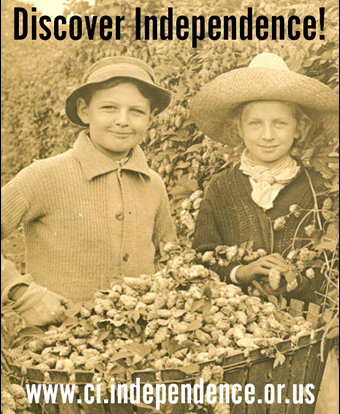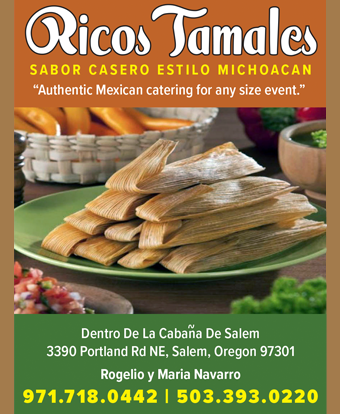Willamette Valley Life: Everything Great About The Willamette Valley
GeerCrest: A Nursery Homestead
By Linda Ziedrich
In the rolling Waldo Hills, about five miles south of the Oregon Garden, sits a 173-year-old homestead still in the hands of its founding family. It’s a fine place to contemplate Oregon history or just admire the stunning view to the west.
Ralph and Mary Geer founded this homestead in 1848, a year after arriving in the Willamette Valley as part of a wagon train. The Geers’ land claim was the second registered in Oregon Territory. From their former farm in Illinois, Ralph had brought along a bushel of apple seeds and a half-bushel of pear seeds. The family planted them and soon they had thousands of little fruit trees. To increase variety, Ralph traded with Henderson Luelling. Luelling, who had also come to the Valley in 1847, brought a big wagonload of grafted fruit trees with him. By grafting Henderson’s cuttings onto Ralph’s rootstock, both were eventually able to harvest dessert apples and pears of then-favorite varieties like seek-no-further, Rambo, and yellow bellflower apples and Flemish and winter Nelis pears. They also sold grafted trees to other homesteaders up and down the coast.
What to See at GeerCrest
The Geer family’s homestead features a rambling clapboard house built in 1851 and an above-ground, stone fruit cellar from 1880, both on a rise above a murmuring stream. Surrounding the buildings are perhaps two dozen tall, old fruit trees and a venerable butternut tree, all of which Ralph Geer likely planted himself. Together they are designated Oregon Heritage Trees. Also near the house is the “riding whip tree,” which Homer Davenport’s mother, Florinda Geer, planted in 1854 by stabbing her switch into the ground after a horse ride. There are also recently planted trees of antique varieties, a vegetable garden and some rare old breeds of livestock.
Famous Geers
The generations who grew up enjoying GeerCrest included Ralph and Mary’s grandson Homer Davenport, a nationally renowned political cartoonist; nephew T. T. Geer, Oregon’s first native-born governor; granddaughter Musa Geer, the first woman to climb Mt. Jefferson and a homesteader and storekeeper in Washington; and grandson Pearl Geer, who cofounded the Liberal University of Oregon and later won fame as an actor.
Arrange a Visit to GeerCrest
The Geer family homestead is now operated as an educational nonprofit. Most years, groups of schoolchildren come here to learn such skills as milking goats, making cider, and nixtamalizing corn.
Partially because of the pandemic, GeerCrest’s directors are now concentrating on restoring the buildings. “But we still love to have visitors!” says Adam McKinley, GeerCrest’s farm director. If you live nearby, you can volunteer to help at the farm once or twice per week (see geercrest.org/volunteer). In winter, you can order grafted trees of heritage varieties to pick up in the spring. You can even camp at GeerCrest—in your tent or RV, in a rustic cabin with a fireplace, or even in a treehouse (geercrest.org/stay). Tours are available by appointment. Call 503-873-3406 or write info@geercrest.org.
Linda Ziedrich writes about food from her home in Oregon's Willamette Valley, where she continually experiments with the fruits and vegetables she grows. The Joy of Pickling, The Joy of Jams, Jellies, and Other Sweet Preserves, and Cold Soups are fruits of her empirical research as well as her studies of culinary traditions around the world. For more information about Linda's work, see her blog at agardenerstable.com.
Tap Photo To See Details
John Donaghue: Ringmaster Of The Circus of Possibilities
Interview by Sarah Horner
John Donoghue isn’t known for just one thing. Instead, he’s known for several things, and for doing them all at the same time. His art and music are an eclectic collection of found objects, moving parts, and seemingly endless creativity.
Donoghue’s day job is in the Oregon mushroom industry, providing consultation to commercial and home growers on cultivation, farm design, and troubleshooting. He’s also a musician has played with old-style string band Wild Hog in the Woods for nearly three decades. He’s also know for the circus-style organs he built from scrap items and junkshop finds, the marionettes that accompany his music and the artful “crankies” he creates as an homage to the precursor to motion pictures.
When asked how he has time for all these endeavors, Donoghue chuckles and says, “I don’t sleep that much.”
“I love to create animated things out of inanimate objects,” he says.
“Bringing things to life is fun, to make them dance.
Children love it. It’s kid magic.”
Before the pandemic, John and the three other members of Wild Hog in the Woods played gigs two to three times a week. Of course, like so many other things, live shows were canceled starting last March. But Donoghue was determined to keep entertaining. He converted a trailer into a colorful “circus wagon”: the side drops down and the roof lifts to create a portable stage. Wild Hog in the Woods offered well-received pop-up concerts during the warmer months at local parks.
As if it weren’t enough for Donoghue to play numerous instruments (including the mandolin, guitar, harmonica, cello and more), this artful music man creates marionettes out of items he finds at thrift shops. “I love to create animated things out of inanimate objects,” he says. “Bringing things to life is fun, to make them dance. Children love it. It’s kid magic.” Donoghue explains that he connects the marionettes to instruments so that they move with the music, animated with a pedal, for example. He and the band love to busk at farmers markets and delight audiences with their tunes and puppets.
Given Donoghue’s penchant for animation, music and vintage aesthetic, it’s no surprise he creates crankies as well. A crankie is an old storytelling art form that pre-dates motion pictures. It’s comprised of a long, illustrated scroll that is wound onto two spools and viewed through a box. The scroll is hand-cranked while the story is told, often accompanied by a song or music. Donoghue recently contributed his creations to the Berkeley Oldtime Music Convention’s Crankie Cabaret.
Donoghue frequents a scrapyard where he finds materials he needs for his mushroom business. During one visit, he recounts, he found a bin filled with old organ pipes. He ended up taking them, hatching the idea for what became “The Organism.” It’s an incredible one-person band supported by an elaborate, hand-made system of instrumentation. Using the organ pipes as a foundation, Donoghue plays this hand-crafted instrument with foot pedals that operate a mechanism similar to a bike horn. He can play the harmonica at the same time, using his hands to play the mandolin or other string instrument. Sometimes Donoghue plays a modified euphonium, also sourced from old, dilapidated finds, that’s fitted with a kazoo as a mouthpiece, creating its own unique sound. Visitors to Oregon’s Country Fair likely have enjoyed the spectacle and sound of Donoghue and his "Circus of Possiblities" as he has dubbed it.
Donoghue lives, creates, and plays in Corvallis. He and his wife have three adult children and two grandchildren who live close enough to enjoy the sounds, sights and many delights that Donoghue has created.
Sarah Horner is a freelance writer, photographer and Oregon wine industry professional. She and her husband are empty nesters who live with three cats on a small orchard in Amity, OR.
John Donaghue: Ringmaster Of The Circus of Possibilities
Interview by Sarah Horner
John Donoghue isn’t known for just one thing. Instead, he’s known for several things, and for doing them all at the same time. His art and music are an eclectic collection of found objects, moving parts, and seemingly endless creativity.
Donoghue’s day job is in the Oregon mushroom industry, providing consultation to commercial and home growers on cultivation, farm design, and troubleshooting. He’s also a musician has played with old-style string band Wild Hog in the Woods for nearly three decades. He’s also know for the circus-style organs he built from scrap items and junkshop finds, the marionettes that accompany his music and the artful “crankies” he creates as an homage to the precursor to motion pictures.
When asked how he has time for all these endeavors, Donoghue chuckles and says, “I don’t sleep that much.”
“I love to create animated things out of inanimate objects,” he says.
“Bringing things to life is fun, to make them dance.
Children love it. It’s kid magic.”
Before the pandemic, John and the three other members of Wild Hog in the Woods played gigs two to three times a week. Of course, like so many other things, live shows were canceled starting last March. But Donoghue was determined to keep entertaining. He converted a trailer into a colorful “circus wagon”: the side drops down and the roof lifts to create a portable stage. Wild Hog in the Woods offered well-received pop-up concerts during the warmer months at local parks.
As if it weren’t enough for Donoghue to play numerous instruments (including the mandolin, guitar, harmonica, cello and more), this artful music man creates marionettes out of items he finds at thrift shops. “I love to create animated things out of inanimate objects,” he says. “Bringing things to life is fun, to make them dance. Children love it. It’s kid magic.” Donoghue explains that he connects the marionettes to instruments so that they move with the music, animated with a pedal, for example. He and the band love to busk at farmers markets and delight audiences with their tunes and puppets.
Given Donoghue’s penchant for animation, music and vintage aesthetic, it’s no surprise he creates crankies as well. A crankie is an old storytelling art form that pre-dates motion pictures. It’s comprised of a long, illustrated scroll that is wound onto two spools and viewed through a box. The scroll is hand-cranked while the story is told, often accompanied by a song or music. Donoghue recently contributed his creations to the Berkeley Oldtime Music Convention’s Crankie Cabaret.
Donoghue frequents a scrapyard where he finds materials he needs for his mushroom business. During one visit, he recounts, he found a bin filled with old organ pipes. He ended up taking them, hatching the idea for what became “The Organism.” It’s an incredible one-person band supported by an elaborate, hand-made system of instrumentation. Using the organ pipes as a foundation, Donoghue plays this hand-crafted instrument with foot pedals that operate a mechanism similar to a bike horn. He can play the harmonica at the same time, using his hands to play the mandolin or other string instrument. Sometimes Donoghue plays a modified euphonium, also sourced from old, dilapidated finds, that’s fitted with a kazoo as a mouthpiece, creating its own unique sound. Visitors to Oregon’s Country Fair likely have enjoyed the spectacle and sound of Donoghue and his "Circus of Possiblities" as he has dubbed it.
Donoghue lives, creates, and plays in Corvallis. He and his wife have three adult children and two grandchildren who live close enough to enjoy the sounds, sights and many delights that Donoghue has created.
Sarah Horner is a freelance writer, photographer and Oregon wine industry professional. She and her husband are empty nesters who live with three cats on a small orchard in Amity, OR.
Tap Photo To See Details
It's All In A Name
Prior to white settlers arriving in the Oregon Territory, the area that would become Oregon’s Willamette Valley was populated by many people, particularly the indigenous Kalapuya people.
Following the Louisiana Purchase in 1803, President Thomas Jefferson sent Meriwether Lewis and William Clark and their Corps of Discovery across that expansive acquisition. Their expedition reached the Pacific Ocean in 1805. Just over 30 years later, the first permanent white settlers arrived in Oregon, kicking off “The Great Migration” along the Oregon Trail between 1843 and 1869. They brought their personal and collective experiences with them, adding to the long history recorded by the area’s Native residents.
This time period held events of great consequence to the country. The Industrial Revolution – a period of worldwide technological, economic and cultural upheaval – came to a close. Oregon became a state. The American Civil War began and ended. Slavery was outlawed. The nation lost a historic presidency to an assassin. The transcontinental railroad became a reality, crisscrossing the nation. And all of this was just the beginning.
Through it all, Oregon communities formed, grew, and took on names. So what’s in a name? Conflict. Possession. Politics. Hopes. Misunderstanding. Legitimacy. All across the United States – and all around the world – place names reveal us. They are filled with who we are, who we were, where we’ve been, and what we dream of. This is as true of the Valley around us as it is the valleys of Ohio, China, or the moon.
Yet the place names of the Willamette Valley reflect something uniquely coalesced, the unusual histories of our varied people interweaving with our varied geography. Before white settlers arrived, the Kalapuya and other Native peoples of the Pacific Northwest had their own names for their own places. The name “Willamette” itself, for example, derives from a French pronunciation of the name of a Clackamas tribal village, an interpretation of self-description. Whether you reside here permanently or are passing through, consider the following a primer to Willamette Valley place name origins—the colorful and the mundane. ...(to be continued)
Tap Photo To See Details
April Waters, Oregon Artist
Oregon fine artist April Waters, holds a bachelor’s degree in fine arts from the University of Colorado at Boulder, and she did further study at the Art Center School of Design in Los Angeles and California State University at Fullerton. She has been featured in numerous solo and group exhibitions over the past 20 years and is included in public and private collections in California and Oregon, including those at Oregon State University, Mt. Angel Abbey and Salem Hospital, among many others.
Tap Photo To See Details












